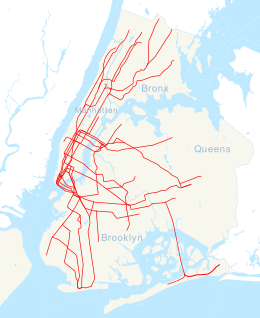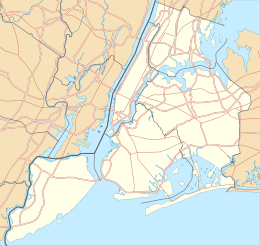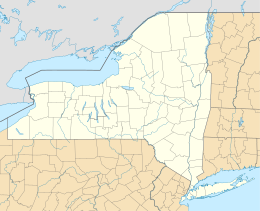railroad.wikisort.org - Station
The 79th Street station is a local station on the IRT Broadway–Seventh Avenue Line of the New York City Subway. Located at the intersection of 79th Street and Broadway on the Upper West Side of Manhattan, it is served by the 1 train at all times and the 2 train during late nights.
79 Street | ||||||||||||||||||||||||||||||||||||||||||||||||||||||||||||||||||||
|---|---|---|---|---|---|---|---|---|---|---|---|---|---|---|---|---|---|---|---|---|---|---|---|---|---|---|---|---|---|---|---|---|---|---|---|---|---|---|---|---|---|---|---|---|---|---|---|---|---|---|---|---|---|---|---|---|---|---|---|---|---|---|---|---|---|---|---|---|
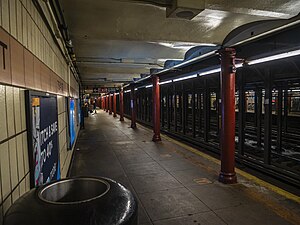 View from northbound platform | ||||||||||||||||||||||||||||||||||||||||||||||||||||||||||||||||||||
| Station statistics | ||||||||||||||||||||||||||||||||||||||||||||||||||||||||||||||||||||
| Address | West 79th Street & Broadway New York, NY 10024[1][2]: 1 | |||||||||||||||||||||||||||||||||||||||||||||||||||||||||||||||||||
| Borough | Manhattan | |||||||||||||||||||||||||||||||||||||||||||||||||||||||||||||||||||
| Locale | Upper West Side | |||||||||||||||||||||||||||||||||||||||||||||||||||||||||||||||||||
| Coordinates | 40.784°N 73.98°W | |||||||||||||||||||||||||||||||||||||||||||||||||||||||||||||||||||
| Division | A (IRT)[3] | |||||||||||||||||||||||||||||||||||||||||||||||||||||||||||||||||||
| Line | IRT Broadway–Seventh Avenue Line | |||||||||||||||||||||||||||||||||||||||||||||||||||||||||||||||||||
| Services | 1 2 | |||||||||||||||||||||||||||||||||||||||||||||||||||||||||||||||||||
| Transit | ||||||||||||||||||||||||||||||||||||||||||||||||||||||||||||||||||||
| Structure | Underground | |||||||||||||||||||||||||||||||||||||||||||||||||||||||||||||||||||
| Platforms | 2 side platforms | |||||||||||||||||||||||||||||||||||||||||||||||||||||||||||||||||||
| Tracks | 4 | |||||||||||||||||||||||||||||||||||||||||||||||||||||||||||||||||||
| Other information | ||||||||||||||||||||||||||||||||||||||||||||||||||||||||||||||||||||
| Opened | October 27, 1904[5] | |||||||||||||||||||||||||||||||||||||||||||||||||||||||||||||||||||
| Opposite- direction transfer | No | |||||||||||||||||||||||||||||||||||||||||||||||||||||||||||||||||||
| Traffic | ||||||||||||||||||||||||||||||||||||||||||||||||||||||||||||||||||||
| 2019 | 4,745,863[6] | |||||||||||||||||||||||||||||||||||||||||||||||||||||||||||||||||||
| Rank | 96 out of 424[6] | |||||||||||||||||||||||||||||||||||||||||||||||||||||||||||||||||||
| ||||||||||||||||||||||||||||||||||||||||||||||||||||||||||||||||||||
| ||||||||||||||||||||||||||||||||||||||||||||||||||||||||||||||||||||
| ||||||||||||||||||||||||||||||||||||||||||||||||||||||||||||||||||||
| ||||||||||||||||||||||||||||||||||||||||||||||||||||||||||||||||||||
| ||||||||||||||||||||||||||||||||||||||||||||||||||||||||||||||||||||
79th Street Subway Station (IRT) | ||||||||||||||||||||||||||||||||||||||||||||||||||||||||||||||||||||
U.S. National Register of Historic Places | ||||||||||||||||||||||||||||||||||||||||||||||||||||||||||||||||||||
New York City Landmark No. 1096 | ||||||||||||||||||||||||||||||||||||||||||||||||||||||||||||||||||||
| MPS | New York City Subway System MPS | |||||||||||||||||||||||||||||||||||||||||||||||||||||||||||||||||||
| NRHP reference No. | 04001018[2] | |||||||||||||||||||||||||||||||||||||||||||||||||||||||||||||||||||
| NYCL No. | 1096 | |||||||||||||||||||||||||||||||||||||||||||||||||||||||||||||||||||
| Significant dates | ||||||||||||||||||||||||||||||||||||||||||||||||||||||||||||||||||||
| Added to NRHP | September 17, 2004 | |||||||||||||||||||||||||||||||||||||||||||||||||||||||||||||||||||
| Designated NYCL | October 23, 1979[7] | |||||||||||||||||||||||||||||||||||||||||||||||||||||||||||||||||||
The 79th Street station was constructed for the Interborough Rapid Transit Company (IRT) as part of the city's first subway line, which was approved in 1900. Construction of the line segment that includes the 79th Street station began on August 22 of the same year. The station opened on October 27, 1904, as one of the original 28 stations of the New York City Subway. The station's platforms have been lengthened since opening.
The 79th Street station contains two side platforms and four tracks; express trains use the inner two tracks to bypass the station. The station was built with tile and mosaic decorations, although most of the original design has been replaced with a cinder block design. The platforms contain exits to 79th Street and Broadway and are not connected to each other within fare control. The remaining portion of the original station interior is a New York City designated landmark and listed on the National Register of Historic Places.
History
Construction and opening
Planning for a subway line in New York City dates to 1864.[8]: 21 However, development of what would become the city's first subway line did not start until 1894, when the New York State Legislature authorized the Rapid Transit Act.[8]: 139–140 The subway plans were drawn up by a team of engineers led by William Barclay Parsons, chief engineer of the Rapid Transit Commission. It called for a subway line from New York City Hall in lower Manhattan to the Upper West Side, where two branches would lead north into the Bronx.[7]: 3 A plan was formally adopted in 1897,[8]: 148 and all legal conflicts concerning the route alignment were resolved near the end of 1899.[8]: 161
The Rapid Transit Construction Company, organized by John B. McDonald and funded by August Belmont Jr., signed the initial Contract 1 with the Rapid Transit Commission in February 1900,[9] under which it would construct the subway and maintain a 50-year operating lease from the opening of the line.[8]: 165 In 1901, the firm of Heins & LaFarge was hired to design the underground stations.[7]: 4 Belmont incorporated the Interborough Rapid Transit Company (IRT) in April 1902 to operate the subway.[8]: 182
The 79th Street station was constructed as part of the IRT's West Side Line (now the Broadway–Seventh Avenue Line) from 60th Street to 82nd Street, for which work had begun on August 22, 1900. Work for that section had been awarded to William Bradley.[9] By late 1903, the subway was nearly complete, but the IRT Powerhouse and the system's electrical substations were still under construction, delaying the system's opening.[8]: 186 [10] The 79th Street station opened on October 27, 1904, as one of the original 28 stations of the New York City Subway from City Hall to 145th Street on the West Side Branch.[5][8]: 186 The opening of the first subway line, and particularly the 79th Street station, helped contribute to the development of the Upper West Side.[2]: 9
Service changes and station renovations
After the first subway line was completed in 1908,[11] the station was served by local trains along both the West Side (now the Broadway–Seventh Avenue Line to Van Cortlandt Park–242nd Street) and East Side (now the Lenox Avenue Line). West Side local trains had their southern terminus at City Hall during rush hours and South Ferry at other times, and had their northern terminus at 242nd Street. East Side local trains ran from City Hall to Lenox Avenue (145th Street).[12]
To address overcrowding, in 1909, the New York Public Service Commission proposed lengthening platforms at stations along the original IRT subway.[13]: 168 As part of a modification to the IRT's construction contracts, made on January 18, 1910, the company was to lengthen station platforms to accommodate ten-car express and six-car local trains. In addition to $1.5 million (equivalent to $43.6 million in 2021) spent on platform lengthening, $500,000 (equivalent to $14,541,000 in 2021) was spent on building additional entrances and exits. It was anticipated that these improvements would increase capacity by 25 percent.[14]: 15 Platforms at local stations, such as the 79th Street station, were lengthened by between 20 to 30 feet (6.1 to 9.1 m). Both platforms were extended to the north and south.[14]: 111 Six-car local trains began operating in October 1910.[13]: 168 The Broadway–Seventh Avenue Line opened south of Times Square–42nd Street in 1918, thereby dividing the original line into an "H"-shaped system. The original subway north of Times Square thus became part of the Broadway–Seventh Avenue Line, and all local trains were sent to South Ferry.[15]
In December 1922, the Transit Commission approved a $3 million project to lengthen platforms at 14 local stations along the original IRT line, including 79th Street and five other stations on the Broadway–Seventh Avenue Line. Platform lengths at these stations would be increased from 225 to 436 feet (69 to 133 m).[16][17] The commission postponed the platform-lengthening project in September 1923, at which point the cost had risen to $5.6 million.[18][19]
The city government took over the IRT's operations on June 12, 1940.[20][21] The IRT routes were given numbered designations in 1948 with the introduction of "R-type" rolling stock, which contained rollsigns with numbered designations for each service. [22] The Broadway route to 242nd Street became known as the 1 and the Lenox Avenue route as the 3.[23]
The original IRT stations north of Times Square could barely fit local trains of five or six cars depending on the configuration of the trains. Stations on the line from 50th Street to 96th Street, including this station but excluding the 91st Street station, had their platforms extended in the 1950s to accommodate ten-car trains as part of a $100 million (equivalent to $929,566,210 in 2021) rebuilding program.[24] The contract to extend the platforms at 79th Street and 86th Street was awarded to Delma Engineering Corporation for $1,867,705 in 1957 (equivalent to $18,020,000 in 2021).[25] The platform extensions at the local stations were completed by early 1958.[24] Once the project was completed, all 1 trains became local and all 2 and 3 trains became express, and eight-car local trains began operation. Increased and lengthened service was implemented during peak hours on the 1 train on February 6, 1959.[26] Due to the lengthening of the platforms at 86th Street and 96th Street, the intermediate 91st Street station was closed on February 2, 1959, because it was too close to the other two stations.[27][24]

In November 1959, the Warshaw Construction Company received a contract to remove fifteen entrance/exit kiosks on IRT lines, including two at the 79th Street station. This was part of a citywide initiative to remove the kiosks, which obstructed motorists' views of pedestrians.[28] On June 28, 1964, the New York City Transit Authority (NYCTA) awarded a contract to construct additional entrances at the station to Delma Engineering Corporation for $212,874 (equivalent to $1,859,907 in 2021).[29] Work on the project was still underway in 1967.[30]
In April 1988,[31] the NYCTA unveiled plans to speed up service on the Broadway–Seventh Avenue Line through the implementation of a skip-stop service: the 9 train.[32] When skip-stop service started in 1989, it was only implemented north of 137th Street–City College on weekdays, and 79th Street was served by both the 1 and the 9.[33][34][35] Skip-stop service ended on May 27, 2005, as a result of a decrease in the number of riders who benefited.[36][37]
In 1979, the New York City Landmarks Preservation Commission designated the space within the boundaries of the original station, excluding expansions made after 1904, as a city landmark. The station was designated along with eleven others on the original IRT.[7][38] The original interiors were listed on the National Register of Historic Places in 2004.[2]
Station layout
| G | Street level | Exit/entrance |
| P Platform level |
Side platform | |
| Northbound local | ← ← | |
| Northbound express | ← | |
| Southbound express | | |
| Southbound local | | |
| Side platform | ||
Like other local stations, 79th Street has four tracks and two side platforms. The two express tracks are used by the 2 train during daytime hours and the 3 train at all times.[39] The platforms were originally 200 feet (61 m) long, as at other local stations on the original IRT,[7]: 4 [2]: 3 [40]: 8 but as a result of the 1958–1959 platform extension, became 525 feet (160 m) long.[2]: 17 The station was also originally 55.5 feet (16.9 m) wide.[2]: 3
Design


As with other stations built as part of the original IRT, the station was constructed using a cut-and-cover method.[41]: 237 The tunnel is covered by a "U"-shaped trough that contains utility pipes and wires. The bottom of this trough contains a foundation of concrete no less than 4 inches (100 mm) thick.[2]: 3–4 [40]: 9 Each platform consists of 3-inch-thick (7.6 cm) concrete slabs, beneath which are drainage basins. The original platforms contain circular, cast-iron Doric-style columns spaced every 15 feet (4.6 m), while the platform extensions contain I-beam columns. Additional columns between the tracks, spaced every 5 feet (1.5 m), support the jack-arched concrete station roofs.[2]: 3–4 [7]: 4 [40]: 9 The ceiling height varies based on whether there are utilities in the ceiling; the areas without utilities is about 15 feet (4.6 m) above platform level. There is a 1-inch (25 mm) gap between the trough wall and the platform walls, which are made of 4-inch (100 mm)-thick brick covered over by a tiled finish.[2]: 3–4 [40]: 9
The fare control areas are at platform level, and there is no crossover or crossunder between the platforms.[2]: 4 The walls along the platforms near the fare control areas consist of a brick wainscoting on the lowest part of the wall, with bronze air vents along the wainscoting, and white glass tiles above. The platform walls are divided at 15-foot (4.6 m) intervals by buff and salmon tile pilasters, or vertical bands. There are tiled plaques about halfway up each pilaster, with the number "79" in white-on-green tile, and buff-and-salmon foliate designs around them. Atop each pilaster are buff faience plaques depicting two cornucopias around a shield. A cornice with egg-and-dart patterns atop bead-and-reel moldings run atop these walls.[2]: 4–5 [7]: 9 The mosaic tiles at all original IRT stations were manufactured by the American Encaustic Tile Company, which subcontracted the installations at each station.[40]: 31 The decorative work was performed by tile contractor Alfred Boote Company and faience contractor Rookwood Pottery Company.[40]: 37 The ceilings of the original platforms and fare control areas contain plaster molding.[2]: 4–5 [40]: 10 The section of the ceiling north of the fare control area is smooth, and the section south of fare control is composed of segmental vaults supported by the center columns.[2]: 3–4
The remainders of both platforms have cream-colored tiles and a salmon trim line with "79TH ST" written on it in black Sans Serif font at regular intervals. These tiles were installed during the late 1950s renovation.[42][43]
Exits
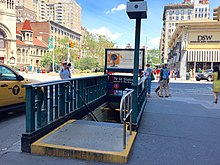
The southbound platform is fully staffed, containing a turnstile bank, token booth, staircase going up to the northwest corner of West 79th Street and Broadway, and passageway separated from the platform by a steel fence leading to a staircase that goes up to the southwest corner of the intersection. This passageway has a High Entry-Exit Turnstile to the platform, with walls made of cinder block tiles.[2]: 4–5, 17 [44]
The northbound platform's fare control is unstaffed, containing a turnstile bank, now-closed customer assistance booth, staircase going up to the southeast corner of West 79th Street and Broadway, and passageway separated from the platform by a steel fence leading to a staircase that goes up to the northeast corner of the intersection. This passageway has a High Exit-Only Turnstile to the platform, with walls made of cinder block tiles.[2]: 4–5, 17 [44] The street staircases on both sides contain relatively simple, modern steel railings like those seen at most New York City Subway stations.[2]: 5–6
References
- "Borough of Manhattan, New York City". Government of New York City. Archived from the original on January 7, 2021. Retrieved December 28, 2020.
- "New York MPS 79th Street Subway Station (IRT)". Records of the National Park Service, 1785 - 2006, Series: National Register of Historic Places and National Historic Landmarks Program Records, 2013 - 2017, Box: National Register of Historic Places and National Historic Landmarks Program Records: New York, ID: 75313925. National Archives.
- "Glossary". Second Avenue Subway Supplemental Draft Environmental Impact Statement (SDEIS) (PDF). Vol. 1. Metropolitan Transportation Authority. March 4, 2003. pp. 1–2. Archived from the original (PDF) on February 26, 2021. Retrieved January 1, 2021.
- "Manhattan Bus Map" (PDF). Metropolitan Transportation Authority. July 2019. Retrieved December 1, 2020.
- "Our Subway Open: 150,000 Try It; Mayor McClellan Runs the First Official Train". The New York Times. October 28, 1904. p. 1. ISSN 0362-4331. Archived from the original on December 13, 2021. Retrieved April 21, 2020.
- "Facts and Figures: Annual Subway Ridership 2014–2019". Metropolitan Transportation Authority. 2020. Retrieved May 26, 2020.
- "Interborough Rapid Transit System, Underground Interior" (PDF). New York City Landmarks Preservation Commission. October 23, 1979. Archived (PDF) from the original on September 21, 2020. Retrieved November 19, 2019.
- Walker, James Blaine (1918). Fifty Years of Rapid Transit — 1864 to 1917. New York, N.Y.: Law Printing. Retrieved November 6, 2016.
- Report of the Board of Rapid Transit Railroad Commissioners for the City of New York For The Year Ending December 31, 1904 Accompanied By Reports of the Chief Engineer and of the Auditor. Board of Rapid Transit Railroad Commissioners. 1905. pp. 229–236.
- "First of Subway Tests; West Side Experimental Trains to be Run by Jan. 1 Broadway Tunnel Tracks Laid, Except on Three Little Sections, to 104th Street -- Power House Delays". The New York Times. November 14, 1903. ISSN 0362-4331. Archived from the original on May 5, 2022. Retrieved May 10, 2022.
- "Our First Subway Completed At Last — Opening of the Van Cortlandt Extension Finishes System Begun in 1900 — The Job Cost $60,000,000 — A Twenty-Mile Ride from Brooklyn to 242d Street for a Nickel Is Possible Now". The New York Times. August 2, 1908. p. 10. Archived from the original on December 23, 2021. Retrieved November 6, 2016.
- Herries, William (1916). Brooklyn Daily Eagle Almanac. The Brooklyn Daily Eagle. p. 119. Archived from the original on May 11, 2021. Retrieved December 19, 2020.
- Hood, Clifton (1978). "The Impact of the IRT in New York City" (PDF). Historic American Engineering Record. pp. 146–207 (PDF pp. 147–208). Archived (PDF) from the original on January 17, 2021. Retrieved December 20, 2020.
 This article incorporates text from this source, which is in the public domain.
This article incorporates text from this source, which is in the public domain.{{cite web}}: CS1 maint: postscript (link) - Report of the Public Service Commission for the First District of the State of New York For The Year Ending December 31, 1910. Public Service Commission. 1911. Archived from the original on January 20, 2021. Retrieved January 7, 2021.
- "Open New Subway Lines to Traffic; Called a Triumph" (PDF). The New York Times. August 2, 1918. p. 1. ISSN 0362-4331. Archived (PDF) from the original on August 3, 2019. Retrieved October 4, 2011.
- "33d Street to Be I.R.T. Express Stop; Reconstruction One of Many Station Improvements Ordered by Commission". The New York Times. December 17, 1922. ISSN 0362-4331. Retrieved June 21, 2022.
- "$4,000,000 in Construction on I. R. T. Ordered: 33d St. on East Side Subway Will Be Express Stop; Local Stations to Have 10-Car Train Capacity Aim to Speed Service Improvements Will Relieve Congestion Along Both Routes. Board Believes". New-York Tribune. December 18, 1922. p. 22. ProQuest 573974563.
- "Express Stop Plan Opposed by I.R.T.; Officials Say Money Is Not Available for Change at 33d Street Station". The New York Times. September 7, 1923. ISSN 0362-4331. Retrieved June 21, 2022.
- "I. R. T. Wins Delay At Subway Platform Extension Hearing: Transit Commission Head Tells Meeting Widening West Side Stations Would Increase Capacity 25 P. C". New-York Tribune. September 7, 1923. p. 6. ProQuest 1237290874.
- "City Transit Unity Is Now a Reality; Title to I.R.T. Lines Passes to Municipality, Ending 19-Year Campaign". The New York Times. June 13, 1940. ISSN 0362-4331. Archived from the original on January 7, 2022. Retrieved May 14, 2022.
- "Transit Unification Completed As City Takes Over I. R. T. Lines: Systems Come Under Single Control After Efforts Begun in 1921; Mayor Is Jubilant at City Hall Ceremony Recalling 1904 Celebration". New York Herald Tribune. June 13, 1940. p. 25. ProQuest 1248134780.
- Brown, Nicole (May 17, 2019). "How did the MTA subway lines get their letter or number? NYCurious". amNewYork. Archived from the original on March 2, 2021. Retrieved January 27, 2021.
- Friedlander, Alex; Lonto, Arthur; Raudenbush, Henry (April 1960). "A Summary of Services on the IRT Division, NYCTA" (PDF). New York Division Bulletin. Electric Railroaders' Association. 3 (1): 2–3. Archived (PDF) from the original on September 14, 2020. Retrieved January 27, 2021.
- "High-Speed Broadway Local Service Began in 1959". The Bulletin. New York Division, Electric Railroaders' Association. 52 (2). February 2009. Archived from the original on September 16, 2016. Retrieved August 26, 2016 – via Issuu.
- Association, General Contractors (1957). Bulletin. pp. 7, 18. Archived from the original on June 15, 2022. Retrieved December 14, 2021.
- "Wagner Praises Modernized IRT — Mayor and Transit Authority Are Hailed as West Side Changes Take Effect". The New York Times. February 7, 1959. p. 21. ISSN 0362-4331. Archived from the original on January 1, 2018. Retrieved November 6, 2016.
- Aciman, Andre (January 8, 1999). "My Manhattan — Next Stop: Subway's Past". The New York Times. ISSN 0362-4331. Archived from the original on August 28, 2016. Retrieved August 26, 2016.
- "15 More City Kiosks Slated for Scrap". The New York Times. November 9, 1959. ISSN 0362-4331. Archived from the original on January 30, 2022. Retrieved January 30, 2022.
- Minutes and Proceedings of the New York City Transit Authority. New York City Transit Authority. 1964. pp. 371–373. Archived from the original on June 15, 2022. Retrieved December 21, 2020.
- Minutes and Proceedings of the New York City Transit Authority. New York City Transit Authority. 1969. p. 198. Archived from the original on June 15, 2022. Retrieved January 25, 2021.
- Brozan, Nadine (June 4, 1989). "'Skip-Stop' Subway Plan Annoys No. 1 Riders". The New York Times. ISSN 0362-4331. Archived from the original on August 10, 2016. Retrieved June 15, 2016.
- Moore, Keith (June 10, 1988). "TA's skip-stop plan hit". New York Daily News. Archived from the original on November 8, 2018. Retrieved November 8, 2018.
- "#1 Riders: Your Service is Changing". New York Daily News. August 20, 1989. Archived from the original on November 8, 2018. Retrieved November 8, 2018.
- "Announcing 1 and 9 Skip-Stop Service on the Broadway-Seventh Avenue Line" (PDF). New York City Transit Authority. August 1989. Archived from the original (PDF) on June 26, 2020. Retrieved August 1, 2009.
- Lorch, Donatella (August 22, 1989). "New Service For Subways On West Side". The New York Times. ISSN 0362-4331. Archived from the original on August 10, 2016. Retrieved June 15, 2016.
- Chan, Sewell (May 25, 2005). "On Its Last Wheels, No. 9 Line Is Vanishing on Signs". The New York Times. ISSN 0362-4331. Archived from the original on March 17, 2015. Retrieved August 29, 2016.
- "Noteworthy – 9 discontinued". mta.info. Metropolitan Transportation Authority. May 7, 2005. Archived from the original on May 7, 2005. Retrieved September 18, 2016.
- "12 IRT Subway Stops Get Landmark Status". The New York Times. October 27, 1979. ISSN 0362-4331. Archived from the original on March 9, 2018. Retrieved December 26, 2020.
- Dougherty, Peter (2006) [2002]. Tracks of the New York City Subway 2006 (3rd ed.). Dougherty. OCLC 49777633 – via Google Books.
- Framberger, David J. (1978). "Architectural Designs for New York's First Subway" (PDF). Historic American Engineering Record. pp. 1–46 (PDF pp. 367–412). Archived (PDF) from the original on January 17, 2021. Retrieved December 20, 2020.
 This article incorporates text from this source, which is in the public domain.
This article incorporates text from this source, which is in the public domain.{{cite web}}: CS1 maint: postscript (link) - Scott, Charles (1978). "Design and Construction of the IRT: Civil Engineering" (PDF). Historic American Engineering Record. pp. 208–282 (PDF pp. 209–283). Archived (PDF) from the original on January 17, 2021. Retrieved December 20, 2020.
 This article incorporates text from this source, which is in the public domain.
This article incorporates text from this source, which is in the public domain.{{cite web}}: CS1 maint: postscript (link) - Tobar, Roberto C. (November 27, 2010). "Platform view". nycsubway.org. Archived from the original on March 1, 2021. Retrieved December 21, 2020.
- Cox, Jeremiah (February 10, 2004). "Looking down towards one end of the platforms at 79 St". subwaynut.com. Archived from the original on September 23, 2019. Retrieved December 21, 2020.
{{cite web}}: CS1 maint: unfit URL (link) - "79th Street Neighborhood Map". mta.info. Metropolitan Transportation Authority. April 2018. Archived from the original on December 20, 2021. Retrieved January 7, 2021.
External links
- nycsubway.org – IRT West Side Line: 79th Street
- Station Reporter – 1 Train
- Forgotten NY – Original 28 - NYC's First 28 Subway Stations (Part 2)
Другой контент может иметь иную лицензию. Перед использованием материалов сайта WikiSort.org внимательно изучите правила лицензирования конкретных элементов наполнения сайта.
WikiSort.org - проект по пересортировке и дополнению контента Википедии
